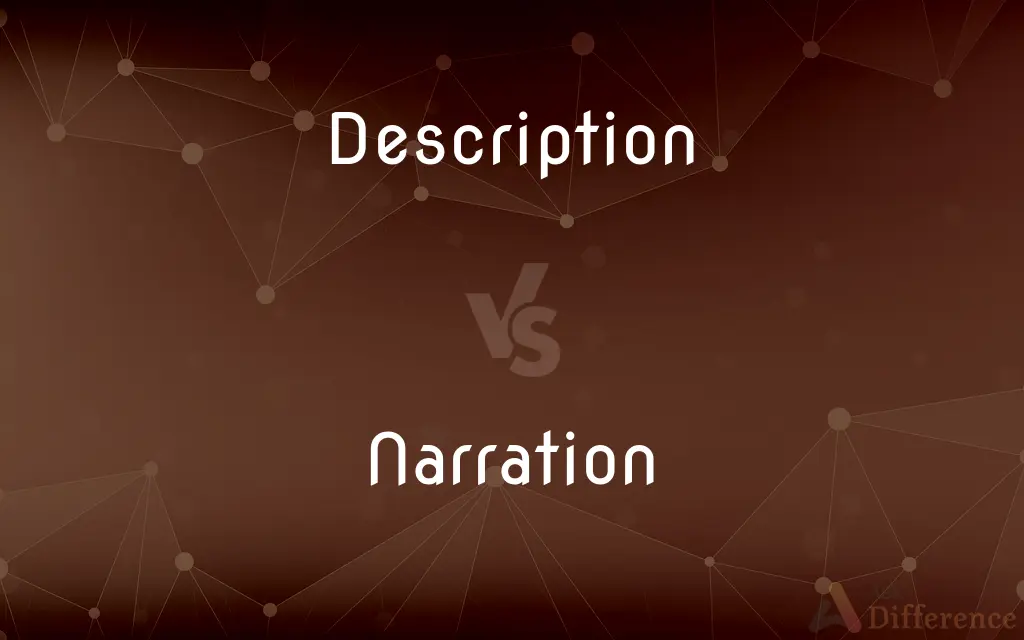Description vs. Narration — What's the Difference?
Edited by Tayyaba Rehman — By Urooj Arif — Updated on March 13, 2024
Description provides detailed information about characteristics and features, focusing on the "what," while narration tells a story, focusing on the "how" and "why" through a sequence of events.

Difference Between Description and Narration
Table of Contents
ADVERTISEMENT
Key Differences
Description involves detailing the characteristics, features, and attributes of a subject, place, or object, aiming to create a vivid mental image for the reader. It focuses on painting a picture through words, allowing the audience to visualize the topic being described. On the other hand, narration is the art of storytelling, presenting a sequence of events in a structured manner. It moves beyond mere depiction to include elements of time, sequence, and perspective, offering a dynamic way to convey experiences, lessons, or messages.
While description emphasizes sensory details such as sights, sounds, smells, tastes, and textures to bring a scene or object to life, narration weaves these details into a storyline. Narration relies on plot, characters, and dialogue to engage the reader, creating a journey that unfolds over time. Whereas description might pause the action to linger on the intricacies of a setting or person, narration propels the audience forward through the actions and reactions of its characters.
Description and narration often intersect in literature and storytelling, where descriptive passages enrich narratives by providing depth and context. Description sets the scene or elaborates on characters' appearances and emotions, enhancing the reader's connection to the narrative. Conversely, narration drives the story, employing description to make the narrative more immersive and compelling.
The purpose behind description and narration can also differ significantly. Description aims to inform, evoke, or persuade by meticulously detailing aspects of the subject. In contrast, narration seeks to entertain, educate, or convey messages and themes through the unfolding of events and interactions between characters. This distinction highlights how each approach serves different communicative goals, from creating atmosphere and depth to engaging and moving the audience.
In terms of structure, description tends to be more static, focusing on depicting a moment in time or the essence of a subject. Narration, by its nature, is dynamic, structured around a beginning, middle, and end to tell a complete story. This fundamental difference underscores the contrasting approaches to engaging with readers whether by inviting them to see, feel, and understand a snapshot in detail or by taking them on a journey through time and experience.
ADVERTISEMENT
Comparison Chart
Focus
Characteristics and features.
Sequence of events and storytelling.
Purpose
To create a vivid mental image.
To tell a story or convey a message.
Elements
Sensory details: sight, sound, etc.
Plot, characters, dialogue, setting.
Engagement
Through detailed imagery.
Through story progression and character development.
Structure
Static, focusing on a moment or essence.
Dynamic, with a beginning, middle, and end.
Compare with Definitions
Description
Aimed at creating a mental image or atmosphere.
The description of the sunset painted a perfect picture in the mind.
Narration
Telling a story or account of events.
The narration of her journey was both thrilling and inspiring.
Description
Depicting characteristics or features.
The description of the haunted house made it feel eerily real.
Narration
Including elements of plot and character.
His narration included unexpected twists that kept readers engaged.
Description
Utilizing sensory details for vivid imagery.
The description of the meal made everyone's mouth water.
Narration
Focusing on the "how" and "why" aspects.
The narration explored the reasons behind the protagonist's decisions.
Description
Focusing on the "what" aspect.
The detailed description of the character helped readers visualize her.
Narration
Employing dialogue and setting to enhance storytelling.
Through skilled narration, the dialogues came alive, echoing the characters' personalities.
Description
Explaining details about an object or scene.
His description of the painting highlighted its emotional impact.
Narration
Aimed at conveying messages or themes.
The story's narration subtly conveyed themes of hope and resilience.
Description
Description is the pattern of narrative development that aims to make vivid a place, object, character, or group. Description is one of four rhetorical modes (also known as modes of discourse), along with exposition, argumentation, and narration.
Narration
Narration is the use of a written or spoken commentary to convey a story to an audience. Narration is conveyed by a narrator: a specific person or unspecified literary voice, developed by the creator of the story, to deliver information to the audience, particularly about the plot (the series of events).
Description
A spoken or written account of a person, object, or event
People who had seen him were able to give a description
Narration
The act, process, or an instance of narrating.
Description
A type or class of people or things
It is laughably easy to buy drugs of all descriptions
Narration
Narrated material.
Description
The act, process, or technique of describing.
Narration
The act of recounting or relating in order the particulars of some action, occurrence, or affair; a narrating.
Description
A statement or an account describing something
Published a description of the journey.
Gave a vivid description of the game.
Narration
That which is narrated or recounted; an orderly recital of the details and particulars of some transaction or event, or of a series of transactions or events; a story or narrative.
Description
A pictorial representation
Monet's ethereal descriptions of haystacks and water lilies.
Narration
(rhetoric) That part of an oration in which the speaker makes his or her statement of facts.
Description
A kind or sort
Cars of every size and description.
Narration
The act of telling or relating the particulars of an event; a recital of certain events, usually in chronological order; rehearsal.
Description
A sketch or account of anything in words; a portraiture or representation in language; an enumeration of the essential qualities of a thing or species.
Give a verbal description of the events
A realistic description
Narration
That which is related; the relation in words or writing of the particulars of any transaction or event, or of any series of transactions or events; a narrative; story; history.
Description
The act of describing; a delineation by marks or signs.
Narration
That part of a discourse which recites the time, manner, or consequences of an action, or simply states the facts connected with the subject.
Description
A set of characteristics by which someone or something can be recognized.
The zoo had no lions, tigers, or cats of any description.
Narration
(rhetoric) the second section of an oration in which the facts are set forth
Description
(taxonomy) A scientific documentation of a taxon for the purpose of introducing it to science.
The type description of the fungus was written by a botanist.
Description
(linguistics) The act or practice of recording and describing actual language usage in a given speech community, as opposed to prescription, i.e. laying down norms of language usage.
Description
(linguistics) A descriptive linguistic survey.
Description
The act of describing; a delineation by marks or signs.
Description
A sketch or account of anything in words; a portraiture or representation in language; an enumeration of the essential qualities of a thing or species.
Milton has descriptions of morning.
Description
A class to which a certain representation is applicable; kind; sort.
A difference . . . between them and another description of public creditors.
The plates were all of the meanest description.
Description
A statement that represents something in words
Description
The act of describing something
Description
Sort or variety;
Every description of book was there
Common Curiosities
How do description and narration impact the reader's experience?
Description enhances the reader's sensory and emotional engagement with the text, while narration guides them through the story, creating a more dynamic and immersive experience.
How does narration differ from simple storytelling?
Narration involves structured storytelling with developed plot, characters, and a clear sequence of events, often aimed at conveying deeper messages or themes.
What is the impact of excessive description in a narrative?
Excessive description can slow down the pace of the narrative, potentially leading to reader disengagement. It's important for descriptions to serve the story by enhancing atmosphere, character, or plot without overwhelming the narrative flow.
Can narration exist without description?
While narration can exist with minimal description, some level of description is typically necessary to create a vivid and engaging story. Description provides the sensory and contextual details that bring a narrative to life.
How can writers balance description and narration in their work?
Writers balance description and narration by integrating descriptive passages that enrich the setting and characters within the flow of the narrative, ensuring that each descriptive detail serves the story's progression.
What makes a good description?
A good description uses vivid sensory details to create a clear and immersive image in the reader's mind, effectively conveying the essence of the subject.
Can description and narration be used together?
Yes, description and narration often complement each other in literature, with description adding depth and context to the narrative.
How do different genres utilize description and narration?
Different genres utilize description and narration in unique ways; for example, fantasy may rely heavily on description to build its world, while thrillers might prioritize fast-paced narration to drive the plot. Each genre tailors the balance to suit its storytelling needs.
Why is narration important in literature?
Narration is crucial for moving the story forward, developing characters, and engaging the reader through a cohesive and compelling sequence of events.
What role does perspective play in narration?
Perspective in narration determines the point of view from which the story is told, influencing the reader's understanding and emotional connection to the events and characters.
Share Your Discovery

Previous Comparison
Clover vs. Shamrock
Next Comparison
Cobble vs. RockAuthor Spotlight
Written by
Urooj ArifUrooj is a skilled content writer at Ask Difference, known for her exceptional ability to simplify complex topics into engaging and informative content. With a passion for research and a flair for clear, concise writing, she consistently delivers articles that resonate with our diverse audience.
Edited by
Tayyaba RehmanTayyaba Rehman is a distinguished writer, currently serving as a primary contributor to askdifference.com. As a researcher in semantics and etymology, Tayyaba's passion for the complexity of languages and their distinctions has found a perfect home on the platform. Tayyaba delves into the intricacies of language, distinguishing between commonly confused words and phrases, thereby providing clarity for readers worldwide.














































